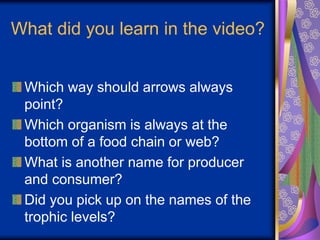
Food chain work for thurs aug 23
- 1. What did you learn in the video? Which way should arrows always point? Which organism is always at the bottom of a food chain or web? What is another name for producer and consumer? Did you pick up on the names of the trophic levels?
- 2. Ultimately all energy comes from… Where does the Earth’s energy come from? Sun Only a tiny fraction is used by plants in photosynthesis…1% Everyone else gets 10% of the energy from the level below them.
- 3. Draw a food chain using hawk, grasshopper, clover plant and rat. Label the trophic levels.
- 4. “Rule of 10” Rule of 10 says that only 10% of the energy available in the lower trophic level goes to the next level. If there is 100 kcal of energy available to the clover plant…how many kcal are available to the other levels? Label the amount of energy passed to each trophic level on your chain.
- 5. 100 kcal 10 kcal 1 kcal 0.1 kcal producer Primary consumer Secondary consumer Tertiary consumer
- 6. Go to p.114 in bio textbook and define the following terms in your notebook: Autotrophs Photosynthesis Chemosynthesis Heterotrophs Phytoplankton Food chain Food web Trophic level biomass After you define the terms, create a food chain using the following organisms: Phytoplankton Bass Blue gill Zooplankton
- 7. Make the following food chain in your notebook: You may need to look up a few terms to do it correctly. Phytoplankton Blue gill Bass Zooplankton Crocodile
- 8. Create a pyramid of energy for your food chain you just created. If there is 1000 KJ (kilojoules) of energy available to your phytoplankton, determine the amount of energy available to each trophic level and draw a pyramid of energy for your food chain.
- 9. Biomass pyramid Biomass is the total mass of a group of organisms in an area
- 10. Why do higher trophic levels contain fewer individuals? W/ the high reduction of energy as it moves up the chain, less is left to support higher-order consumers.
- 11. Include this in your notebook: Where does the Earth’s energy come from? Draw a food chain with your handouts and five organisms. Label the trophic levels. Label the amount of energy available at each level. The amount of energy available to the producers is 1,000 kJ. Draw a biomass pyramid for this food chain. What does a Marsh or wetland look like?